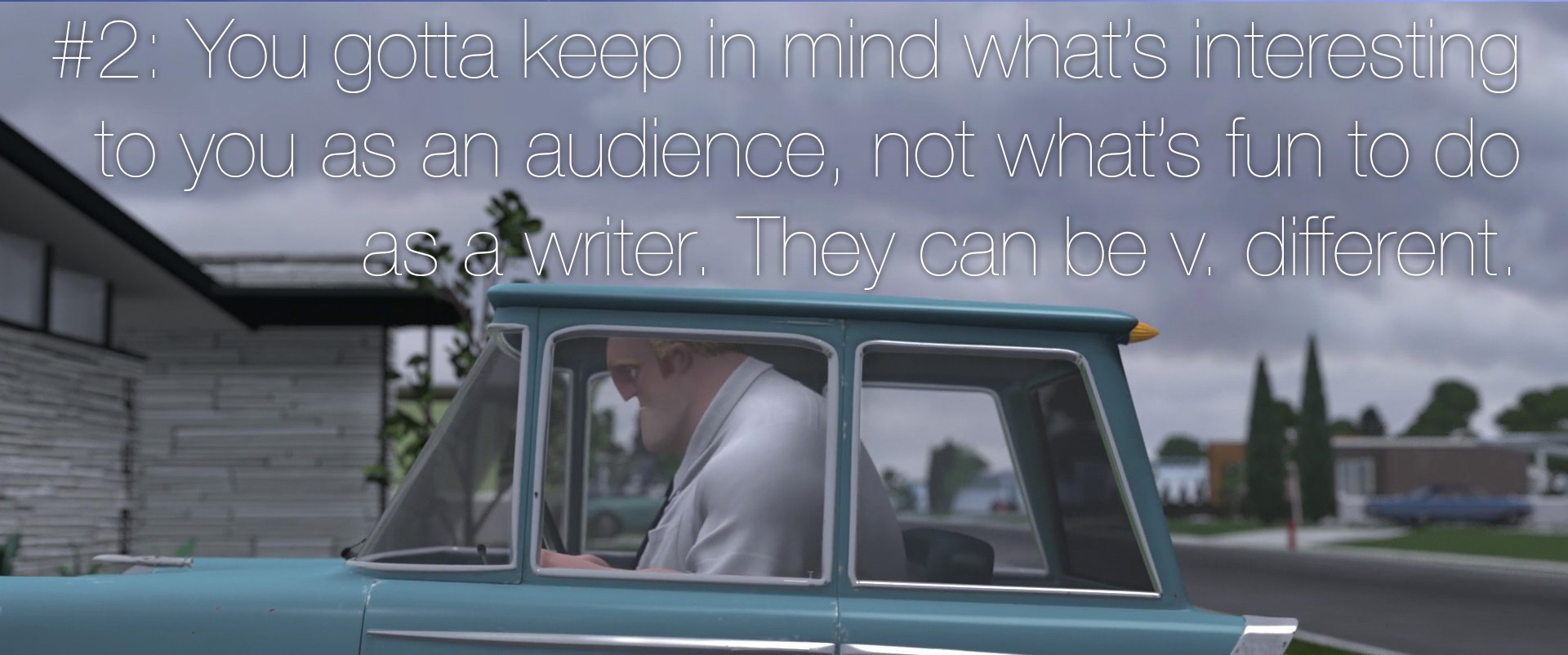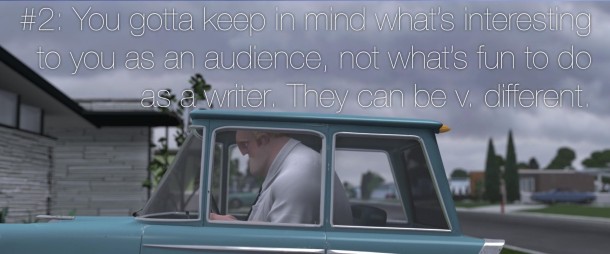A couple of years ago, then Pixar storyboard artist Emily Coats tweeted pieces of advice on making stories that she had picked up from working with Pixar, which were later compiled on in several places on the internet, such as this io9 post. Later, Dino Ignacio created image macros of the individual rules which I am using in these posts.
We’ve got a two-fer today, so let’s get into it.
Rule #2: “You gotta keep in mind what’s interesting to you as an audience, not what’s fun to do as a writer. They can be v. different.”
Planning out the story of the game you are going to be running ahead of time is generally a good idea. It can help give you a lifeline when you’ve hit a brick wall and don’t know where to go next, and it can help lend a cohesive feel to the disparate sessions you run. That said, you need to keep in mind your players and whether what you are planning will be interesting to participate in. All of your plans have to be contingent on the fun of the group.
An example from my own process: I tend to plot out the games I run as a series of important scenes, with connective tissue to get the players from one scene to another filled in as I go. This allows me to get an idea of a rough story arc progressing to a climax. However, when thinking about events that are far into the future of the game’s timeline, it can get easy to lose track of how the players will be involved. I have to stop and ask myself “Is there room for the players to interact in this scene? Is that interaction interesting? Is there even a reason for the PC’s to be here, or could this whole event be summarized for them later?” If I don’t stop and answer those questions, I might end up putting the players through the tabletop equivalent of a lengthy CG cutscene, and they’ll get bored waiting for me to stop soliloquizing so that they can do something (and bored players are dangerous).
Another example, this time from a friend: I know a DM who’s a big fan of weird set-piece battles involving interesting combinations of enemies and terrain, like skeleton archers, perched on a cliff face firing down at the party. This is a great skill for a DM to have, because it helps keep the combat in D&D interesting and fresh. If he loses track of what the PC’s are capable of, though, that interesting set-piece could turn into a tedious slog. Especially if he uses elevated skeleton archers against a party with weak ranged attacks and no ability to fly, forcing them to laboriously scale the cliff to engage each archer in melee. A fun battle for the DM is not necessarily a fun battle for the players.
Rule #3: “Trying for theme is important, but you won’t see what the story is actually about til you’re at the end of it. Now rewrite.”
This ties back into planning out your story. Coming up with a theme (or handful of themes) for your game is a great way to keep it on track, as it gives you a direction to go in when you need to come up with the next session’s story. If you’ve established a theme that underlies many of the story moments in your game, then it will give the players a feeling like everything’s connected in a metaphysical sense, if not a causal sense. Especially if you tie the larger themes into themes the players have indicated interest through their character’s backstories.
Except when the players miss your themes entirely.
Because here’s the thing: The theme you think you’re writing to isn’t always the theme you are actually writing to. You might think your game is about “The Liberation of the Oppressed,” but what you might actually be setting up is “People do Desperate Things When Their Backs are to the Wall,” and you can guess which one your players will pick up on. Your players may even unwittingly reject your themes by having their characters act in opposition to them. For RPG’s, the rule is “you won’t see what the story is actually about until your players get their hands on it.” After all, your players outnumber you, and they’re the ones likely to be telling stories later about what was cool (to them) or meaningful (to them) about your game.
So what can you do? Well, you can pay attention to what your players think your game is about. Pay attention to what they are telling you through the characters’ actions as well as what their characters talk about when they start waxing philosophical. You could even ask them directly after playing for a month or two: “What do you want to explore more in this game? What do you find most interesting about where the story is going so far?” Don’t rely on any one method; the players might think the game is about one thing but have their characters act as though it is about another, whether that be because they haven’t fulled parsed their own thoughts about where things are headed, or because they don’t feel their character has been able to act with the story’s themes just yet.
Of course, you can’t rewrite a game two months into it. Whatever happened in those sessions is set in stone. You can, however, re-contextualize past events. Think of past events in light of the new themes that are arising, and you’ll likely see ways in which they fit together. Fiddling with the motivations and backgrounds of NPC’s that the players haven’t been made aware of yet to jive better with the new direction for the story. Be wary of outright retcons, such as “That guy was actually a doppleganger all along!” as players can generally smell an “Author’s Saving Throw” from a long way off. You might be able to gloss over previously established details that the players overlooked, but do so carefully, as people’s memories can be inconveniently good when it comes to remember details which contradict what you just told them.
Now, this post has been written mainly from the standpoint of a GM who’s using a rule set that gives them most of the narrative power, but what if you’re running a game that’s more player-driven? Figuring out themes is still very useful for those times when you need to give the players a bit of a nudge to keep things moving. Consider the Monster Hearts game Tim was running for us. The way he was running it (and arguably the way Monster Hearts is meant to be run) was to let us bounce off each other getting into fights and tangling up our motivations, while intervening to stir the pot if a scene wasn’t going anywhere. If I had to name a theme for that game, it would be “Sex is Intriguing But Also Terrifying,” because all of our characters were playing with the idea of sex but really reluctant to actually do it. With this idea in mind, if Tim really wanted to shake things up, he could have played to that theme by having an NPC really try to seduce someone, or by putting us in a situation where NPC’s believed that two of our characters were actually having sex, and forcing us to react to those circumstances. You can easily approach theme from the standpoint of reinforcing what your players come up with, as opposed to guiding players towards themes you create.
That’s it for today. Next week: More rules apply to story structure, including some ways to improvise a structure when you’re not the one in control at all.
Once again, we hope you enjoy the content we produce. If you do, please consider a small donation towards our Extra Life Charity Page- really, that’s the entire reason this site and our content exists- to help support Children’s Miracle Network Hospitals. We will also be streaming our 24 hour marathon gaming session starting this Saturday, October 25th at 5:00 PM EST. The Streaming Site can be found at http://www.twitch.tv/aozain. 100% of ALL donations (no matter which team member you sponsor) go to support Hurley Children’s Hospital in Flint, Michigan.
Click HERE to donate to Seth!
Click HERE to donate to David!
Click HERE to donate to Tim!






